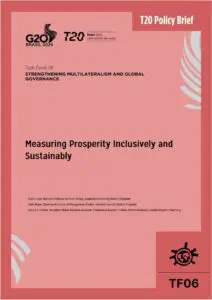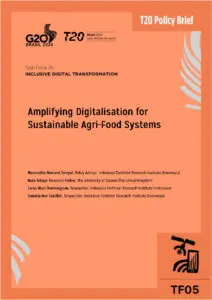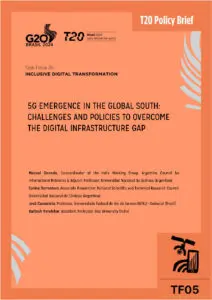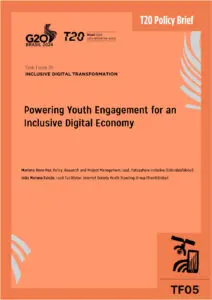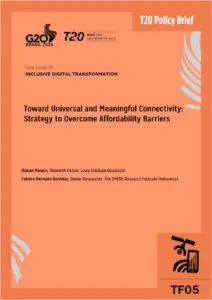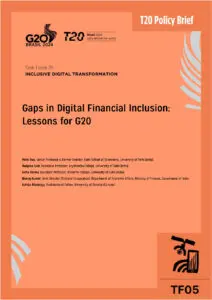Fostering circularity in plastic use can reduce marine litter pollution as well as contribute to retaining plastics and their associated value in the economy. Regulatory and fiscal instruments can integrate recycled plastics as raw material and facilitate recycling at the end of the product life. Financing solutions can support business innovation around the circular supply chain of plastics. Standardizing methods for sampling and analyzing microplastics in the environment and understanding the interaction of plastics with other stressors in the environment is necessary. Public and private sector collaboration can provide the overarching institutional support to foster circularity in plastic use.
Challenge
Coastal ecosystems support many critical services, including water provisioning and purification, protection of coasts, providing nursery and breeding habitats for fish, and storing large amounts of blue carbon. The contamination of marine and coastal environments with plastics and other man-made debris is threatening the blue carbon ecosystems. Fostering circularity in plastic use to close the plastic loop is an effective solution in this regard, but it comes with many challenges.
- Low demand and supply of recycled plastics (materials and products):
- There is tough competition from virgin plastics, both in terms of their relatively lower prices and easier sourcing, facilitated by economies of scale and markets established for them (OECD 2018).
- The advanced processing technologies required for increasing the value retrieved from plastic waste and supplying the high-quality recycled plastics that could substitute the virgin material are not commonly available.
- Lack of design for environment considerations in plastic products and packaging material prevents material reduction and integration for ease of recycling aspects.
- Inadequate standards for quality and testing of recycled plastics.
- Absence of clear product labelling indicating appropriate usage and disposal guidelines.
- Outdated recycling processes leading to lower quality of recycled plastics, often termed “downcycling.”
- Lack of practical and transposable standardized definitions and parameters for biodegradable, compostable, and bio-based plastics.
- Regulatory environment-related challenges for using post-consumer recycled (PCR) and post-industrial recycled (PIR) content for certain specific uses, such as medical devices and their packaging. For example, the resins used in medical grade plastics must be consistent in order to adhere to stringent quality and performance criteria. Introducing PCR and PIR content into the process can lead to variations in consistency, and in turn, potential negative human health impacts (HPRC n.d.).
- The field of ecotoxicology as it pertains to plastics (macro, micro, and nano) continues to evolve. Scientists are in the initial stages of understanding human and animal exposure, as well as the effects of microplastics on populations and ecosystems. The diverse suite of microplastics varies greatly in morphology, chemical properties, texture, color, density, and size. Multiple methodologies have been employed to address a variety of questions regarding plastic and microplastics pollution, from sources, transport, and fate in the environment, as well as their effects on humans and ecosystems (Cowger et al. 2020; Geyer, Jambeck, and Lavendar Law 2017). These vastly different methods are often inadequately described, use plastic concentration orders of a magnitude higher than that found in the environment, and employ non-environmentally pertinent conditions. Therefore, the resulting studies are neither comparable nor reproducible (SAPEA 2019). The World Health Organization states that the lack of standard methods for sampling and analyzing microplastics in the environment makes comparisons across studies difficult (2019).
Proposal
Proposal I
G20 member countries should strengthen and expand upon existing regulatory and fiscal measures to mandate and incentivize the use of recycled plastics, including material and products, as well as efficient plastic product and packaging design, incorporating designs for recyclability and reduction. Financing solutions can support business innovation around the circular supply chain of plastics.
Rationale
To support markets for recycled materials, policies must address the supply and demand of recycled materials and products. These policies must account for the dual goal of facilitating consumer acceptance and providing incentives for producers and their suppliers (OECD 2018).
Fiscal measures can reduce the use of virgin plastics and increase the use of recycled plastics in production, creating demand for recycled plastic upstream in the supply chain. This in turn expands the incentives for increased collection and the recycling of plastic material downstream. These measures can also stimulate the phasing out of commonly identified problematic packaging or products (Ellen MacArthur Foundation 2019).
A regulatory push that leads to more demand for recycled plastic material and products should be a key focus. The push could be recycled content targets for new plastic products to help create a large, reliable market that the plastic recycling industry can build upon, and that product manufacturers can work toward for fulfilling targets. The European Green Deal, aimed to put Europe on track to reach net-zero global warming emissions by 2050, notes that under its new circular economy plan, the European Commission will develop requirements to ensure that all packaging in the European Union (EU) market is reusable or recyclable in an economically viable manner by 2030. The European Strategy for Plastics in a Circular Economy has emphasized on integrating recycled content in the green public procurement criteria as one of the priorities to foster this foreseen 2030 target.
The Single Use Plastics Directive of the EU, which bans and restricts the use of various types of single-use plastics—such as knives, forks and straws—from 2021 onward, marks the beginning of a transition toward making plastics more circular (EEA 2019).
Public procurement has been shown to be a powerful tool for promoting and accelerating market entry while simultaneously positively influencing consumers’ opinions (Dietrich et al. 2017). There are examples of public procurement of products made with recycled plastic and/or plastic products designed for easy recycling. The House of Commons (Environment Audit Committee) in the United Kingdom has called for a mandatory requirement of 50% recycled content in the production of new plastic bottles by 2023, which will help create demand and stimulate a circular economy for recycled plastic bottles (BPF n.d.).
While designing/re-structuring regulations, supplementing them with incentivizing mechanisms may be required. For example, to promote reverse logistics for plastic waste collection, government support through legislation, and incentives and commitment from key actors in the supply chain to invest in infrastructure and technology for managing plastic waste must be increased (Tran 2018).
Further, legislations pertaining to plastics should be harmonized between and within countries.
Suggestions for the implementation of the above proposal
- G20 countries should re-focus fiscal measures to stimulate the supply side of recycled plastic materials and products by reducing the subsidies for hydrocarbons, as hydrocarbons serve as input for the conventional fossil-based virgin plastic production. Differentiated taxes should be imposed on virgin and recycled plastic, and the cost of externalities linked to the two types of plastics should be internalized. Extended producer responsibility fees could be levied/modulated to encourage more sustainable design of plastic products and packaging material and for the use of recycled as opposed to virgin plastics. Corporate tax credits could be provided to initiatives by the private sector to scale up existing and build new recycling infrastructure. Taxes should be levied on the use of known hazardous additives, difficult to recycle polymers, or even non-essential single-use plastic products, to discourage their use.[1] Penalties could be used to penalize packaging made up of materials that are difficult to separate or recycle, as well as improper waste disposal by industry and individuals.
- G20 countries should design inclusive and innovative financing solutions beyond fiscal measures for business innovation around a circular supply chain of plastics. This could be done through the creation of a dedicated innovation fund, effectively catalyzing efficient and equitable use, and the mobilization of domestic and international resources. Venture capital (VC) funds could be one of the key methods to mobilize resources. For example, the Singapore-based VC fund Management Company, Circulate Capital, launched a $106 million fund dedicated to solving Asia’s plastic crisis in December 2019. Other financing solutions include access to institutional finance to meet working capital requirements, viability gap funding, green bonds, blended finance, risk insurance and impact investing, and risk guarantee funds to enterprises that are engaged in plastic waste collection and management in key “hotspot” areas.
- G20 countries should set standards and provide certification and labels for quality and use of recycled material. This would ensure safety and enable confidence and acceptability by industries using the material as input and consumers utilizing the products. Industry associations can play a role in developing and propagating the adoption of these standards and benchmarks. In the absence of formal standards, industry-wide benchmarks could play a similar role.
- G20 countries should harmonize quality standards to enable cross-border secondary material flows. This will enable uniformity in composition at the design stage for products, such as making all bottle caps from the same polymer. For example, in the USA, recycled plastics intended for use with food must comply with the relevant requirements of Chapter 21 of the Code of Federal Regulations. The US Food and Drug Administration (FDA) has prepared a detailed guidance for the use of the recycled plastics in the packaging sector (FDA 2006).
- G20 countries should develop and mandate R&D Regulations. Globally standardized field collection, sampling, testing, and analysis methodologies for microplastic waste, as well as standardized risk assessment methods for microplastic waste are needed so that plastics are utilized comparably and in similar regulatory contexts.
Proposal II
G20 member countries, in collaboration with the private sector, should provide institutional support to business models and eco-innovations around circular supply chain of plastics, such as those around sustainable plastic waste recovery and its recycling.
Rationale
The capacity for innovation and support of start-up entrepreneurial activities focused around eco-innovation, sustainable plastic waste recovery, and recycling of plastics must be enhanced. Partnerships, platforms, and networks among key stakeholders can accelerate the transition toward a circular economy by enabling experience and knowledge sharing.
Digital technologies can facilitate the creation of interactive platforms. Digital technology can help in reviving the old established model of deposit refund system monetizing savings made in carbon footprints. The rise of waste exchanges via digital platforms facilitates circulation of information and exchange of materials. It is cheaper for users to search for and create lower recovery and transportation costs for those generating and collecting the waste. Waste exchange platforms are also increasingly being used to connect waste generators, waste managers, and potential users of waste products, and facilitate e-procurement of waste for further processing. Existing good practices in the G20 countries should be studied, and opportunities for their replication must be explored.[2]
Since waste management and recycling in low- and middle-income countries are often informal, there is an urgent need to support these processes and enable their integration into evolving waste management processes. Though they demonstrate substantial, efficient recovery practices in a cost-effective manner, their working conditions are characterized by poor occupational and health safety conditions and high fragmentation. The sector must be integrated into the larger plastic waste value chains. A recent study by Gall et al. (2020) finds that, through the right model of cooperation, post-consumer plastic waste sourced from informal waste pickers in a lower-middle income country can be processed into materials that are comparable to state-of-the-art recyclates obtained from an advanced formal recycling system in a high-income country. Such cooperation can create socio-economic and societal improvements for the people working and living in that sector.
The transition toward a circular economy based around plastic wastes will require newer skills and technical knowledge. Re-skilling requirements also occur when digital technology creates systemic shifts in the division of work between labor and machines, as well as newer platforms.
Suggestions for the implementation of the above proposal
- G20 countries should advocate for the integration of the informal sector with the formal sector in the waste management domain to leverage each other’s best practices. They should push for the creation of a data bank system of informal sector workers and their registration at the local government level which can facilitate digital waste platforms. Further, training and capacity building should be provided for improving the efficiencies of plastic waste collection and in recycling and processing.
- G20 countries should encourage the sharing of best practices of digital policy interventions among themselves, as well as practices, lessons learned, and solutions, including those in response to unprecedented situations such as the COVID-19 pandemic. The Digital Economy Task Force of the G20 can be engaged in these efforts. Currently, the task force is trying to encourage the dissemination of current and emerging digital tools for fighting the pandemic.
- Creating awareness about new business models through knowledge sharing sessions and workshops could play a vital role in catalyzing circular model innovations and their adoption and engagement by stakeholders. For this, the G20 could utilize its convening power to bring stakeholders together and create awareness. It could ensure clear and consistent messaging, facilitate action among members, drive the comprehensive analysis of new business models, and share knowledge and developing partnerships. Campaigns for social branding based on circularity of products should be designed to increase the market value of circular products.
- G20 countries should participate in and encourage the creation of alliances and partnerships with firm commitments to promoting action on a circular plastics economy. For example, the European Commission in 2019 launched the Circular Plastics Alliance,[3] under which businesses and all relevant stakeholders collaborate to improve the design for recyclability of plastic materials, improve the quality and increase the quantity of recyclates, and boost the collection and sorting of plastic waste. Such alliances help in understanding the opportunities for assessing interventions required and channelizing advocacy and investments to facilitate rapid transformations. Another example is the global network Resource Efficient and Cleaner Production Network (RECPnet) that promotes resource-efficient cleaner production and facilitates collaboration including through the transfer of relevant knowledge, experiences, and technologies.
- G20 countries must consider investing in skills, starting from early education, to be a key element of its commitment to fostering a circular economy. This should be accompanied with investments and strategies for vocational training and nonvocational adult learning. Collaboration and cooperation with non-G20 countries, local governments, and related stakeholders, namely private sector and civil society organizations, in undertaking skill-building activities could be encouraged.
- Setting up incubators and accelerators, through public and private partnership modes, that can provide funding, link entrepreneurs with academics and industry professionals for mentoring, training, and provide engagement to start-ups that make resource efficiency and a circular economy central to their business models. The Circulate Initiative by Circulate Capital and Circular Economy incubator by Austin Technology Incubator are examples of such institutions. Clear and transparent protocols are important for showcasing the solutions offered by the business models, whether through large scale pilots or smaller demonstration projects.
- G20 countries should mainstream the integration of life cycle assessments for evaluating the environmental impact of plastics and bio-based alternatives. In this context, the Work with Life Cycle Initiative, a public-private, multi-stakeholder partnership hosted by the UN Environment Program, can promote global consensus on life cycle impact assessment indicators and encourage countries to standardize the use of these assessments. This global forum and partnership would ensure a science-based, consensus-building process to support decisions and policies toward the shared vision of sustainability as a public good. Further, G20 governments should charter pathways for the adoption of global life cycle assessment standards. Such metrics can accurately determine if the United Nations Framework Convention on Climate Change performance indicators and UN Sustainable Development Goals are being achieved.
- G20 countries should commit to engaging in the Plastic Waste Partnership established under the Basel Convention on the Control of Transboundary Movement of Hazardous Wastes and their Disposal to mobilize business, government, academic and civil society resources, to improve and promote the environmentally sound management of plastic waste at the global, regional and national levels and to prevent and minimize its generation.
Proposal III
G20 member countries should standardize: methods for sampling and analyzing microplastics in the environment; exposure modeling for accurately assessing hazards; and risk assessments for evaluating and understanding the interaction of plastics with other stressors in the environment.
Rationale
Despite inconsistencies in the field of microplastics, the common denominator is that additional scientific research and cross-border access to standardized data is required to improve our understanding of microplastics and inform concrete, legally binding regulations (SAPEA 2019; WHO 2019a, 2019b; Amaral-Zettler et al. 2016; Lynch n.d.). The development of a clear and reliable framework regarding microplastics via scientifically validated methodologies to achieve standardization is required. This, in turn, would provide the tools and robustness required to monitor microplastics and influence regulatory direction.
Harmonized reporting guidelines for microplastic studies in environmental and laboratory settings are needed. These include best practices for reporting materials, quality assurance/quality control, data, field sampling, sample preparation, microplastic identification, categorization, and quantification, and considerations for toxicology studies (Zhao et al. 2018). Organizations like ASTM International, the International Standard Organization, and the European Committee for Standardization are developing microplastic standards both at the regional and the international level. Standardized sampling, testing, measuring, and analytical methodologies are critical for understanding the toxicity and the effects of plastics to humans and biomes. Without standardization, the world cannot fully comprehend the effects of plastics on the entire ecosystem, including microplastics below the ocean’s surface, or in freshwater systems.
Suggestions for the implementation of the above proposal
- Given the international nature of our economy and supply chains, microplastics are a cross-border issue, requiring global cooperation and action. G20 countries should agree to develop standardized scientific methods to detect, identify, quantify, and suitably characterize microplastics.
- Sustainable governance of the marine environment requires a multidisciplinary, scientific understanding of marine ecosystems and human activities that affect them. The G20 member countries should engage with the Joint Group of Experts on Scientific Aspects of Marine Protection (GESAMP) Working Group 40 (WG40) that oversees issues relating to “sources, fate and effects of plastics and microplastics in the marine environment.” The GESAMP mechanism functions under the auspices of ten UN Organizations, all with substantial maritime and ocean interests and potentially overlapping responsibilities.
- In 2019, Science Advice for Policy by European Academies (SAPEA) conducted a scientific evidence review report on microplastics. The G20 National Academies of Sciences should utilize the findings of this scientific perspective and provide a neutral and global platform for international initiatives and standards development cooperation. This would elevate and amalgamate the work of microplastics standardsetting organizations (ASTM International, American National Standards Institute (ANSI), NSF International, and International Organization for Standardization), trade associations, academia, and other relevant entities.
The G20 can enhance global governance on marine litter and plastic waste by working with the UN Environment Assembly to ensure that the member states’ action plans on marine litter reduction contain commitments to standardized methods for sampling and analyzing microplastics by coordinating within the UN system and with GESAMP, the G20 National Academies of Sciences, SAPEA, ASTM International, ANSI, NSF International, and other relevant entities.
Key Recommendations
- G20 member countries should strengthen and expand upon existing regulatory and fiscal measures to mandate and incentivize the use of recycled plastics, materials and products, and the design of efficient plastic products and packaging. Designs that improve recyclability and reduce plastic use must be incorporated. Financing solutions could support business innovation around the circular supply chain of plastics.
- G20 member countries, in collaboration with the private sector, should provide institutional support to business models and eco-innovations around a circular supply chain of plastics, such as sustainable plastic waste recovery and recycling. This support should include access to digital technology and platforms, addressing knowledge and information gaps, setting up of incubators and accelerators, and skill building and training.
- G20 member countries should standardize methods for sampling and analyzing microplastics in the environment and facilitate exposure modeling to properly assess hazards. They must conduct risk assessments to evaluate and understand the interaction of plastics with other stressors in the environment.
Disclaimer
This policy brief was developed and written by the authors and has undergone a peer review process. The views and opinions expressed in this policy brief are those of the authors and do not necessarily reflect the official policy or position of the authors’ organizations or the T20 Secretariat.
References
Amaral-Zettler, Linda, Anthony Andrady, Sarah Dudas, Joan Fabres, Francois
Galgani, Denise Hardesty, Valeria Hidalgo-Ruz, Sunny Hong, Peter Kershaw, et al. 2016. “Sources, Fate and Effects of Microplastics in the Marine Environment: Part 2 of a Global Assessment.” edited by Peter J. Kershaw and Chelsea M. Rochman. London: International Maritime Organization. https://www.gesamp.org/site/assets/files/1275/sources-fate-and-effects-of-microplastics-in-the-marine-environment-part-2-of-aglobal-assessment-en.pdf.
Anastasia, Maura., and Nix, James., n.d. ‘Plastic Bag Levy in Ireland’. Green Budget Europe and Institute European Environmental Policy. Accessed August 05, 2020. https://ieep.eu/uploads/articles/attachments/0817a609-f2ed-4db0-8ae0-05f1d75fbaa4/IE%20Plastic%20Bag%20Levy%20final.pdf?v=63680923242.
British Plastics Federation (BPF). n.d. “Axion: UK Should ‘Create Demand For Recycled Materials’.” BPF website. Accessed June 05, 2020. https://www.bpf.co.uk/article/axionuk-should-create-demand-for-recycled-materials-1262.aspx.
Cowger, Win, Andy M. Booth, Bonnie M. Hamilton, Clara Thaysen, Sebastian Primpke, Keenan Munno, Amy L. Lusher et al. 2020. “Reporting Guidelines to Increase the Reproducibility and Comparability of Research on Microplastics.” Applied Spectroscopy. https://doi.org/10.1177/0003702820930292.
Dietrich, Karolin, Marie-Josée Dumonta, Luis F. Del Rio, and Valérie Orsata. 2017. “Producing PHAs in the Bioeconomy—Towards a Sustainable Bioplastic.” Sustainable Production and Consumption 9: 58–70. https://doi.org/10.1016/j.spc.2016.09.001.
EEA. 2019. “The Plastic Waste Trade in the Circular Economy.” European Environmental Agency website. October 28, 2019. Last updated July 23, 2020. https://www.eea.europa.eu/themes/waste/resource-efficiency/the-plastic-waste-trade-in.
Ellen MacArthur Foundation. 2019. “New Plastics Economy Global Commitment: 2019 Progress Report.” Ellen MacArthur Foundation website. Last updated October 1, 2019. https://www.ellenmacarthurfoundation.org/assets/downloads/Global-Commitment-2019-Progress-Report.pdf.
FDA. 2006. “Guidance for Industry: Use of Recycled Plastics in Food Packaging (Chemistry Considerations).” Accessed August 05, 2020. https://www.fda.gov/regulatory-information/search-fda-guidance-documents/guidance-industry-userecycled-plastics-food-packaging-chemistry-considerations.
Gall, Markus, Melanie Wiener, Cintia Chagas de Oliveira, Reinhold W. Langa, and Erik G. Hansen. 2020. “Building a Circular Plastics Economy With Informal Waste Pickers: Recyclate Quality, Business Model, and Societal Impacts.” Resources, Conservation and Recycling 156: 104685. https://doi.org/10.1016/j.resconrec.2020.104685.
Geyer, Roland, Jenna R. Jambeck, and Kara Lavender Law. 2017. “Production, Use, and Fate of All Plastics.” Science Advances 3, no. 7: e1700782. https://www.science.org/doi/10.1126/sciadv.1700782.
HPRC. n.d. “Circularity for Healthcare Plastics: The Challenges and Opportunities.” Healthcare Plastics Recycling Council website. Accessed June 10, 2020. https://40864656-dd71-4c8a-a82d-dffa36a152a5.filesusr.com/ugd/49d7a0_f370df582eb545358d2da474df6b8ac0.pdf.
Lynch, Jennifer M. n.d.. “Plastic Pollution Measurement Science.” National Institute of Standards and Technology website. Last updated January 2013. https://www.nist.gov/programs-projects/plastic-pollution-measurement-science.
National Academies of Sciences, Engineering, and Medicine. 2020. Closing the Loop on the Plastics Dilemma: Proceedings of a Workshop–in Brief. Washington, DC: The National Academies Press. https://doi.org/10.17226/25647.
Nielsen, Tobias Dan, Karl Holmberg, and Johannes Stripple. 2019. “Need a Bag? A Review of Public Policies on Plastic Carrier Bags – Where, How and to What Effect?” Waste Management 87: 428–40. https://doi.org/10.1016/j.wasman.2019.02.025.
OECD. 2018. “Improving Plastics Management: Trends, Policy Responses, and the Role of International Co-Operation and Trade.” OECD Environmental Policy Paper No. 12. Last updated September 2018. https://www.oecd.org/environment/waste/policy-highlights-improving-plastics-management.pdf.
Plastics Europe. “Plastics – The Wonder Material” Last updated September 2013. https://www.plasticseurope.org/documents/document/20131017112406-10_plastics_the_wonder_material_ final_sept_2013.pdf.
SAPEA. 2019. A Scientific Perspective On Microplastics in Nature and Society. Berlin: Germany. https://doi.org/10.26356/microplastics.
Scott, Alex. 2019. “The Pervasiveness of Microplastics.” Chemical and Engineering News 97 no. 5. Last updated February 4, 2019. https://cen.acs.org/environment/pollution/pervasiveness-microplastics/97/i5.
Tran, Thi Thu Huong and Huong Luc. 2018. “Reverse Logistics in Plastic Supply Chain: The Current Practice in Vietnam.” In Nachhaltige Impulse für Produktion und Logistikmanagement, edited by Irina Dovbischuk, Guido Siestrup, and Axel Tuma (pp. 219–33). New York: Springer. https://doi.org/10.1007/978-3-658-21412-8_18.
World Health Organization. 2019a. “Microplastics in Drinking-Water.” World Health Organization website. Last updated 2019. https://apps.who.int/iris/bitstream/handle/10665/326499/9789241516198-eng.pdf?ua=1.
World Health Organization. 2019b. “WHO Calls For More Research Into Microplastics and a Crackdown on Plastic Pollution.” World Health Organization press release. August 22, 2019. Accessed June 05, 2020. https://www.who.int/news-room/detail/22-08-2019-who-calls-for-more-research-into-microplastics-and-a-crackdown-onplastic-pollution.
Zhao, Shiye, Lixin Zhu, Lei Gao, and Daoji Li. 2018. “Limitations For Microplastic Quantification in the Ocean and Recommendations For Improvement and Standardization.” In Microplastic Contamination in Aquatic Environments: An Emerging Matter of Environmental Urgency, edited by Eddy Y. Yeng, 27–49. London: Elsevier. https://doi.org/10.1016/B978-0-12-813747-5.00002-3.
Appendix
[1] . One such example if that of Ireland where a levy on plastic bags reduced the consumption of plastic bags by 90% (Nielsen et al. 2019). Ireland’s plastic bag tax revenue is earmarked not only to cover administration costs but also to cover environmental funds used to support waste management, litter clean-up, and other environmental initiatives (Anastasia and Nix n.d.) Other examples include Scotland and Belgium.
[2] . One such example is the Kabadiwalla Connect, a technology-based social enterprise based in Chennai city in India that uses a technology platform to leverage the existing informal infrastructure and makes their ecosystem more accessible for players aiming toward a more efficient waste management system. This access enables the municipalities to utilize informal infrastructure to lower operational costs. Waste management firms can source from it, corporations can carry out their extended producer responsibility through it. Moreover, apartments and small businesses can send their recyclable waste directly to informal stakeholders that are a part of the informal ecosystem. This could be replicated in other parts of the world, which would enable the implementation of extended producer responsibility, which is becoming a common mandate.
[3] . This is a high-level, multi-stakeholder platform, with strong visibility and political support, dedicated to the achievement of specific objectives within a limited timeframe. The Alliance gathers more than 170 stakeholders covering the full plastics value chains (from waste collectors to recyclers to converters, brand owners and retailers).



